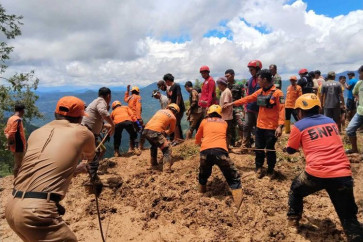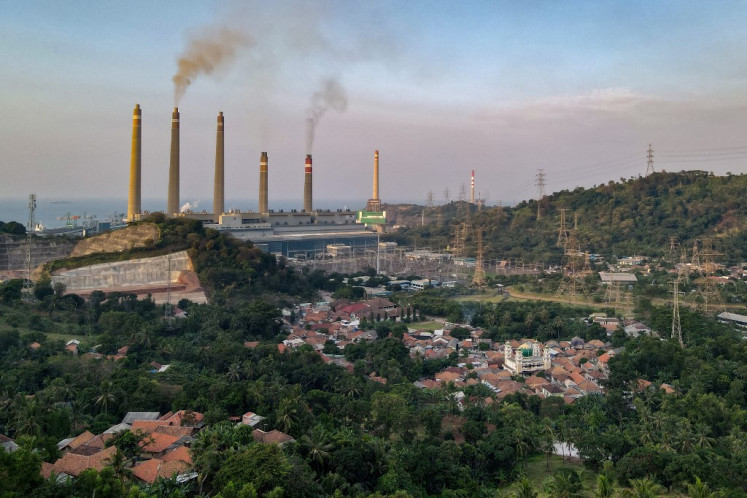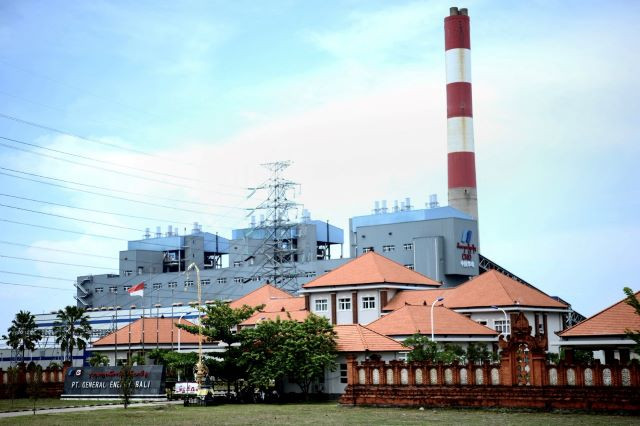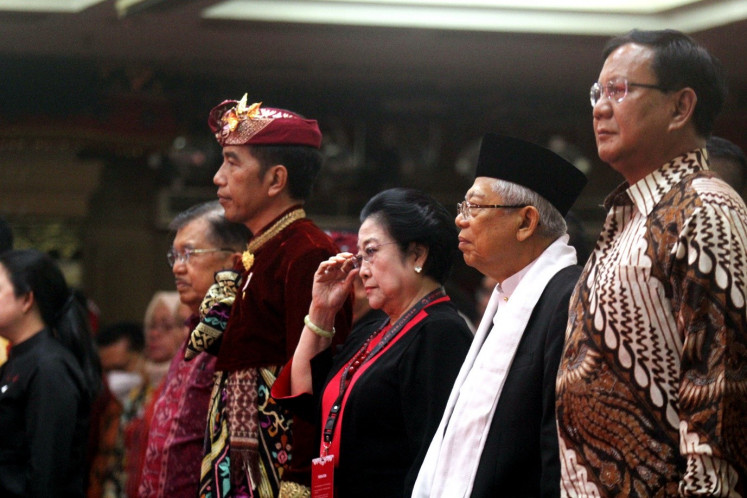Unsung heroines: Green warriors
However, a report published by UN Women Watch in 2009 pointed out that women also acted as effective agents of change in mitigating natural disasters and promoting adaptation strategies. The closeness between working-class women and nature strengthens their position as preservers of local wisdom on environmental protection that gets passed down through generations.
Change Size
 One of nine female farmers of Mount Kendeng, Rembang regency, Central Java protest against cement plants developments in their area by cementing their feet in front of the State Palace, Jakarta, on Wednesday, 13 April 2016. They demanded to meet with the President to voice their concerns over the plants' construction that would harm the environment and threaten their livelihoods as farmers. (The Jakarta Post/Seto Wardhana)
One of nine female farmers of Mount Kendeng, Rembang regency, Central Java protest against cement plants developments in their area by cementing their feet in front of the State Palace, Jakarta, on Wednesday, 13 April 2016. They demanded to meet with the President to voice their concerns over the plants' construction that would harm the environment and threaten their livelihoods as farmers. (The Jakarta Post/Seto Wardhana)
A
recent demonstration carried out by nine women from Mount Kendeng, Rembang, in protest against a cement plant development in their Central Java hometown managed to catch the public’s eye. They cemented their feet for two days in front of the State Palace to attain President Joko “Jokowi” Widodo’s attention and his support for their protest against the development by the cement firm in their area, seen as a threat to their livelihoods and the local ecosystem.
Sukinah, one of the female protestors, dubbed “Kartini of Kendeng”, after national heroine RA Kartini, stated that their protest was based on nature needing to be preserved. They insisted any potential harm from cementing their feet inside large wooden boxes was insignificant compared to the longer-term damage the cement firm would do to their community and future generations. The cement plant could cause the loss of 51 million liters of water from the protesters local environment, experts say, while also disrupting the groundwater basin. This symbolic act was the women’s last resort after years of fruitless protests.
Netizens asked, where were the men in the protest? Environmental degradation surely impacts both men and women, but the burden often falls disproportionately on the latter. Studies show that women are more vulnerable to climate change due to an unequal distribution of roles, resources and power. In developing countries including Indonesia, women, particularly working-class women, are simultaneously domestic caretakers and paid laborers.
They thus feel acutely dependent on natural resources, such as agricultural production, water and firewood. Environmental problems thus affect both their homes and their livelihoods; unequipped with the power or resources to adapt, women are most likely to be hit the hardest.
However, a report published by UN Women Watch in 2009 pointed out that women also acted as effective agents of change in mitigating natural disasters and promoting adaptation strategies. The closeness between working-class women and nature strengthens their position as preservers of local wisdom on environmental protection that gets passed down through generations. The Kartinis of Kendeng have proven that despite a lack of formal education, they have a deep knowledge of this issue, including of the potential environmental impact of the cement plant. They have also demonstrated strong advocacy strategies, making their voices and concerns be heard as they fight for their rights.
The Kartinis of Kendeng represent only one of many similar movements. As women’s livelihoods depend heavily on the environment, they quite naturally live and work on the frontline of environmental protection.
For instance, in Sungai Berbari village in Siak regency, Riau, conflict occurred when a palm oil company reneged on its commitment to twice-a-day wet down the main roads passed by its heavy vehicles.
As a result, the severe volume of dust from the roads created respiratory problems among locals, particularly children. After several attempts to confront the company failed, the local women took the initiative to blockade the road with logs until the company finally fulfilled their demands.
In East Nusa Tenggara, one of the most notable demonstrations took place in Mount Mutis, Timor island. Led by a local woman known as Mama Aleta Baun, 150 women carried out a peaceful protest called a “weaving protest”. Occupying the marble rocks of a mining site, they quietly weaved traditional cloths in protest against the company’s mining activities that were damaging the local forest.
Without the forest, the women would lose their source of livelihood; the place where they collect food, herbs and raw materials for cloth-weaving. Mama Aleta later won the 2013 Goldman Prize from the Goldman Environmental Foundation for her leadership in protecting natural resources.
Thus, the question is not why women are taking action. With women’s strong record of environmental protection, the question should be: Why have we overlooked these women’s actions until today?
This is perhaps due to the fact that their protests have one thing in common: they are all non-violent. The women of Kendeng used their bodies as a symbol to communicate peaceful resistance, while the women of East Nusa Tenggara and Riau tapped into their local wisdom to design peaceful strategies.
Excluding women from the discourse of conflict resolution means losing a vital partner in the struggle for environmental protection and, ultimately, human rights.
By dismissing the significance of their peaceful gestures, we risk losing the opportunity of learning. Learning from and listening to the locals, particularly women, is the key to managing the risk of environmental disasters. But are we willing to learn?
RA Kartini, the heroine of women’s rights, expressed herself through her letters, the only option at the time. Now, modern-day Kartinis are expressing their political beliefs by weaving, cementing their feet and taking to the streets – whatever it takes for them to make their voices heard. We should at least listen.
***
The authors are recipients of the Indonesia Endowment Fund for Education ( LPDP ) and researchers at the Women Research Institute. The opinions expressed are their own.
---------------
We are looking for information, opinions, and in-depth analysis from experts or scholars in a variety of fields. We choose articles based on facts or opinions about general news, as well as quality analysis and commentary about Indonesia or international events. Send your piece to community@jakpost.com.









